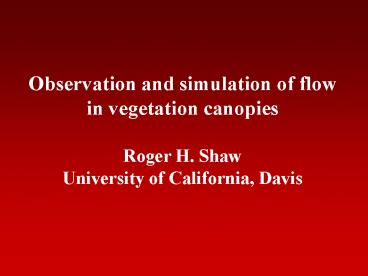Observation and simulation of flow in vegetation canopies
1 / 52
Title:
Observation and simulation of flow in vegetation canopies
Description:
Kinetic energy spectral densities that are strongly peaked ... Galileo Galilei. Time traces of velocity components. Z=2.4h. Z=0.9h ... –
Number of Views:94
Avg rating:3.0/5.0
Title: Observation and simulation of flow in vegetation canopies
1
Observation and simulation of flow in vegetation
canopies Roger H. Shaw University of California,
Davis
2
(No Transcript)
3
Canopy turbulence
- Kinetic energy spectral densities that are
strongly peaked - Strong correlations between streamwise and
vertical velocities - Large velocity skewness (Skugt0 Skwlt0)
- Transport dominated by organized structures
- Larger contributions from sweep motions than
ejections
4
We will understand the movement of the stars
long before we understand canopy
turbulence Galileo Galilei
5
(No Transcript)
6
(No Transcript)
7
Time traces of velocity components
8
Z2.4h
9
Z0.9h
10
Scalar ramps correlated through the depth of
the canopy show wholesale flushing of the
canopy airspace by large scale gusts.
11
(No Transcript)
12
(No Transcript)
13
Scalar
14
Vertical velocity
15
Streamwise velocity
16
Turbulent kinetic energy budget determined from
LES
17
Large-eddy simulation of surface and canopy layers
- Based on NCAR code developed by Moeng (1984)
- Modified to include drag effects on both the
resolved-scale - flow and SGS motions
- An experimental tool and framework for
investigation - of observed phenomena
18
Resolved- and subgrid-scales in large-eddy
simulation (LES)
2?
19
LES resolved- and subgrid-scales
20
- periodic horizontal boundary conditions
- frictionless lid at upper boundary (no flux)
- uniform force to drive the flow
- scalar source through depth of canopy
21
- Canopy specification
- Represented at each grid point by element
- area density a (m2/m3)
- Area density horizontally uniform but a(z)
- Canopy elements rigid
- Volume occupied by solid elements is
- considered to be negligible
22
Static pressure perturbation
23
Resolved- subgrid- and wake-scales
2?
24
Internal energy
Mean flow KE
Resolved-scale TKE
3
Subgrid-scale TKE
1
2
25
Viscous drag
Internal energy
8
9
10
Mean flow KE
Resolved-scale TKE
3
Subgrid-scale TKE
1
2
Wake-scale TKE
7
6
4
5
Form drag
26
Drag parameterization
Blasius solution for flow parallel to a flat
plate
27
inertial cascade
form drag
?
SGS energy pool
28
inertial cascade
form drag
?sgs
?w
SGS energy
wake energy
29
Subgrid-scale energy equation
where
30
Wake-scale energy equation
where
31
(No Transcript)
32
(No Transcript)
33
(No Transcript)
34
- Additional variable ew to represent kinetic
energy - associated with wake motions
- Dissipation of ew controlled by dimension of
- canopy elements
35
- Additional variable ew to represent kinetic
energy - associated with wake motions
- Dissipation of ew controlled by dimension of
- canopy elements
- Rate of conversion of kinetic energy from
- resolved scales to wake scales is large
- Effective diffusivity of wake-scale turbulence
- can be ignored
36
- Additional variable ew to represent kinetic
energy - associated with wake motions
- Dissipation of ew controlled by dimension of
- canopy elements
- Rate of conversion of kinetic energy from
- resolved scales to wake scales is large
- Effective diffusivity of wake-scale turbulence
- can be ignored
- Important to include the conversion of resolved
- and SGS energy to wake-scale kinetic energy
37
- Additional variable ew to represent kinetic
energy - associated with wake motions
- Dissipation of ew controlled by dimension of
- canopy elements
- Rate of conversion of kinetic energy from
- resolved scales to wake scales is large
- Effective diffusivity of wake-scale turbulence
- can be ignored
- Important to include the conversion of resolved
- and SGS energy to wake-scale kinetic energy
- Viscous drag and direct dissipation in viscous
- boundary layers of leaves is of little
consequence
38
(No Transcript)
39
(No Transcript)
40
Conditional sampling of LES output and composite
averaging of flow structures
- Pressure signal at z/h1 used as detection
function - Structures aligned according to peak in pressure
signal - Composite averages of various elements of the
structures
Approximately 1,600 events extracted from one
30-minute time series (but not all independent)
41
(No Transcript)
42
(No Transcript)
43
(No Transcript)
44
(No Transcript)
45
270 seconds (17 frames)
46
(No Transcript)
47
(No Transcript)
48
(No Transcript)
49
(No Transcript)
50
The structure of the large-eddy motion as a
solution to the eigenvalue problem
Where Fij is the spectral density tensor fi is
the eigenvector l is the associated eigenvalue
51
(No Transcript)
52
(No Transcript)































